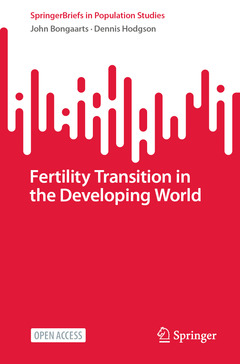Fertility Transition in the Developing World, 1st ed. 2022 SpringerBriefs in Population Studies Series
Auteurs : Bongaarts John, Hodgson Dennis

Dennis Hodgson is Emeritus Professor of Sociology at Fairfield University where he taught from 1976 until 2014. He has been on the editorial committee of Population and Development Review from 2010 through 2021. He holds a Ph.D. in Sociology from Cornell University where he was a student in its International Population Program from 1969 until 1976. Hodgson’s research has focused on understanding the relationship of population trends to the development of population theory and policy. He has published a number of articles analysing the post-WWII period when most demographers came to see the rapid growth of population in the developing world as a crisis in need of policy intervention. He has also published articles on the role that population concerns have played at various times in US history, from the 18th century through the early 20th century.
This book is open access and thus freely available online
Presents an overview of one of the most consequential population trends
Discusses the reproductive behaviour transition since 1950
Shows determinants, consequences and related policy and political issues
Date de parution : 09-2022
Ouvrage de 144 p.
15.5x23.5 cm
Thèmes de Fertility Transition in the Developing World :
Mots-clés :
Open Access; Fertility transition; Developing world; Determinants of fertility; Family planning programs; Population policies; Fertility policies; Fertility trends; Fertility decline; Fertility preferences; Socio-economic determinants in fertility decline; Demographic transition; Impact of population policies; Political controversy over population policy; Reproductive behaviour transition



